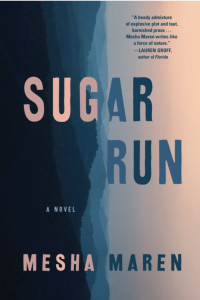by BRENDAN CHAMBERS

Mesha Maren, Sugar Run (Algonquin Books, 2019), pp. 320.
Sugar Run is a book about time, how it plunges forward, divides, and folds back on itself. Between the novel’s dual plots, the chasm of years seems at once unbridgeable and immediately proximate. The neatly divided sections, alternately headed “1988” and “2007,” would have you believe that they can contain what they purport to hold; however, their contents have a way of bleeding into one another: the past recurs in the present as the present colors remembrance of the past. The past’s sweetness is distant while its horrors are disturbingly present, and Jodi McCarty stands straddled between them.
At age seventeen, Jodi is sentenced to life in prison after being convicted of killing her girlfriend, Paula. Sugar Run picks up eighteen years later when Jodi is suddenly released, a beneficiary of a government program which grants clemency to those given life sentences as minors. She finds herself at a bus stop on her way to Chaunceloraine, GA, pushed forward by imperatives—an aborted rescue mission, an impending parole meeting—but caught in stasis. While collecting herself in the relative privacy of a seedy hotel on the outskirts of Chaunceloraine, Jodi meets the childlike, yet worldly Miranda–similarly biding her time in the room next door–and everything is quickly thrown back into motion. After the whirlwind intrusion of Miranda and her three boys, Jodi suddenly finds herself in roles both familiar (lover to a woman she hardly knows) and strange (sometimes surrogate mother to the boys). The four invaders supplant Jodi’s unsteady equilibrium with the energy that drives this novel to its conclusion.
Mesha Maren, like Jodi, was born and raised in Appalachia. She grew up in the woods of West Virginia, in a house her father built himself. Her writing grows from these rural beginnings, bringing to light a space often hidden or ignored, though one that many seem to yearn to understand–think the Hillbilly Elegy phenomenon–due to its outsized influence on the current sociopolitical landscape. Sugar Run, like many of her stories, is set in these hidden spaces, in groves obscured from prying eyes which explode with life once one pulls aside the vegetation. In her writing, Appalachia is laid bare. Maren exposes both its powerful, organic beauty in her descriptions of the land, as well as those more insidious elements, fracking and addiction, which threaten its existence.

Over the course of a short career, Maren has established herself as a relevant and prolific writer. She has published short stories and essays in a variety of literary journals. She was the recipient of the 2015 Thomas Wolfe Fiction Prize and recently served as the 2018-2019 Kenan Visiting Writer here at the University of North Carolina at Chapel Hill. Most recently, she published Sugar Run, her debut novel, with Algonquin Books, a Chapel Hill-based publishing house.
Interjections are omnipresent in Sugar Run, snippets of conversation, memories, dreams, and even people. The reemergence of Paula’s younger brother, Ricky, is perhaps the most important of these. He is penance personified, a way for Jodi to repay for the wrongs that she committed against his sister. He is the physical instantiation of the history which Jodi longs for, yet cannot ever reclaim. In 1988, Jodi and Paula promised to take Ricky with them to rescue him from the abuse and neglect he was suffering at home. Though that promise was suspended for the eighteen years of Jodi’s sentence, she reswears it upon her release, leading her back to the people, places, and patterns of her youth. Though she wonders about Ricky, Jodi could just as easily ask of herself, “how you can possibly protect someone from their own past.”
These incursions end up breaking down the chronological divisions in the story, setting up pairings of past and present which blend into one another. Upon returning to her hometown, Jodi notes, “Time did not separate here. The past ran parallel and you could catch a glimpse if you turned quickly enough.” Memories of Paula flow into experiences with Miranda. The young Ricky reappears in the stunted, childish actions of Ricky as an adult. And the continuity of Jodi from then to now seems disjointed, nonlinear, and multilayered, as 1988 ripples into 2007, living just below, and occasionally above, the surface.
After leaving prison, Jodi remains trapped. In her first night outside, with her defenses down, the past slips in. She dreams of her parents, a scene imagined or remembered from their abusive relationship which “glowed so hot it obliterated everyone else.” They intrude on Jodi’s present, not content to be confined to the past. As she says, “they were always merging together that way or careening apart, messy and pathetic, the wet cotton of regret already filling their mouths.” In her dream they ricochet off of one another and into Jodi’s present reality. Upon awakening, she hears a couple fighting in the next room over, Miranda and her erstwhile husband, Lee Golden.
Maren’s writing style mirrors this unpredictable narrative. Descriptions of the world of Sugar Run seem to melt, blur, and swirl together. Sensuality overrules the formality and logic of time, tossing it aside in favor of a dreamy immediacy, paradoxical though that may sound. In the dark hotel room during her first night with Miranda, Jodi slides back into a memory, leading Paula through the caves under the McCarty homestead, though its vividness makes it feel much more like reality than reverie:
“Their eyes adjust and they quit falling, eventually, over every bump and start seeing the outlines of the stalagmites under their feet, the long white drips of icicle rocks, and green lichen glowing on fallen slabs of stone. They leave the second chamber and bend again, bowing to their knees as they make their way into the throne room…When they emerge everything is fuzzed up with the soft mauve of evening and lightning bugs just beginning to flint along the edges of the trees. Jodi can feel Paula beside her, taking it all in, and she wonders if the heart of this place is visible to her.”
The pages drip with sensory detail, but also with a smoothness which washes over the reader rather than overwhelming them. Present or past seems to make little difference to a moment’s import. Objects in memory are as solid as those in the present, objects in the present as ephemeral as those in memory.
When we first meet Miranda, swimming in the motel’s pool, we see her as she sees herself, “as if she was on camera.” The scene exemplifies Maren’s descriptive ability and penchant for the unexpected yet incisive word. Walking out of her hotel room after swallowing a handful of Adderall, “the amphetamine jangl[ing] in her veins,” both we and Miranda are awash in the “warm ripeness” of her body “which seems more fully hers” as well as the “cosmic yearnings” which impel it. The characters are at once deeply in the world and floating above it, grounded to reality by their physicality yet fighting to detach themselves—through sex, alcohol, and relationships—and escape into the world of memories.
Maren’s work has been compared to other writers of “grit lit,” a traditionally male-dominated genre, but one that she both conforms to and challenges with her unique approach. While the basic tenets of this style of writing are there—an unromantic Southern setting, seedy locales, poverty, addiction—Sugar Run does more than run the course of a tenacious hard-luck story. Maren crafts a work which is vigorous, exciting, and original. Her writing style is immersive, with gripping narrative and vivid description working in tandem to draw and keep you in this world. While at times uncomfortably smooth and seductive, Maren’s ability to make such a unique experience seem universal and immediate is always impressive.
The work is not perfect, surely. Maren’s lack of book-length experience comes through towards the end of the novel when things begin to unravel, not in the stylized manner which has characterized the writing before it, but pushing the boundaries of belief. The realism which Maren had worked to cultivate seems to fall apart in shootouts and car chases that occasionally verge on the melodramatic, pressing incongruously towards the end. The result feels, in some ways, like a rushed conclusion to a novel which has otherwise been unafraid to revel in description and development.
The end result, however, is a work which ultimately hangs together. The force of Maren’s writing, its tactility and sensuality, overpowers any issues with narrative and makes the work cohere. Her characters, Jodi, Paula, Miranda, Ricky, all come to occupy a space both in the novel and in the reader’s mind which exists outside of any chronologically progressing narrative. Their voices spin together and compel you to listen, to allow yourself to, as Jodi both fears and desires, “slip through the fabric of time and get trapped somewhere between dream and memory.” If you do so, you will not regret it.

